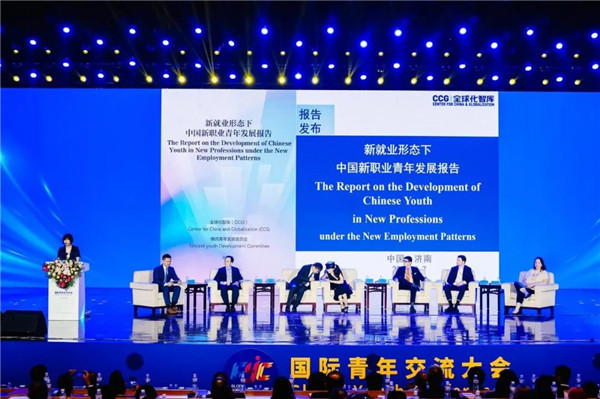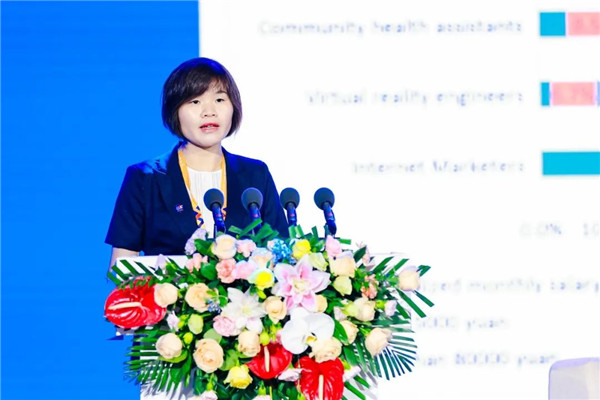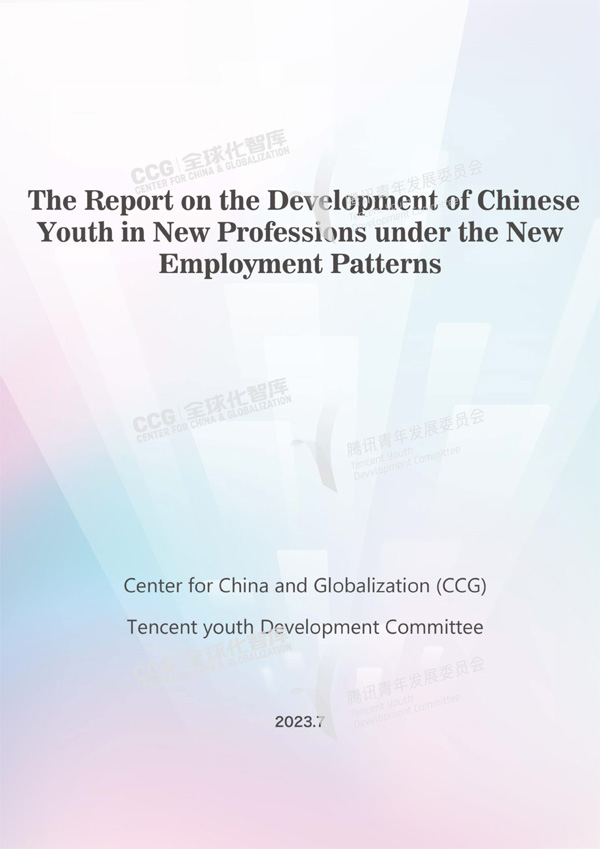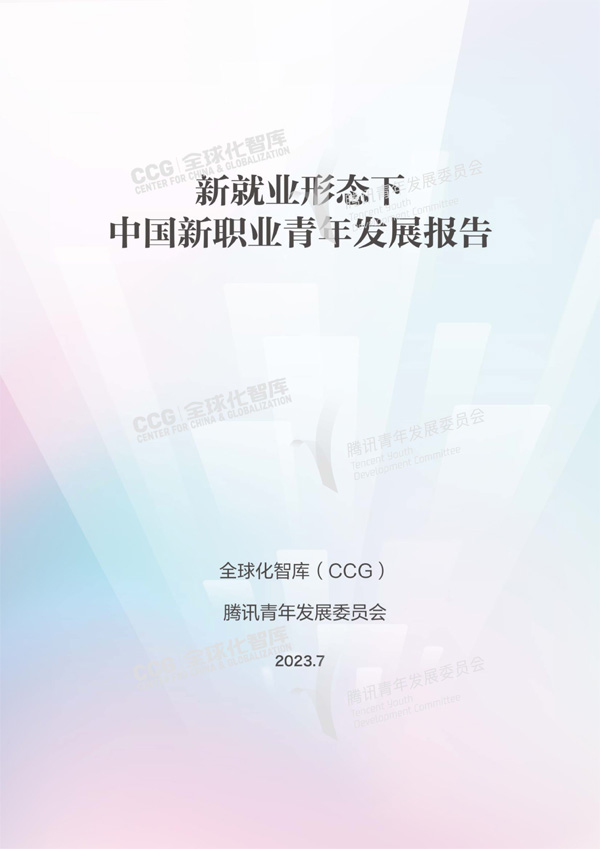CCG Release a Report on Chinese Youth in New Professions
On July 7, 2023, the “The Report on the Development of Chinese Youth in New Professions under the New Employment patterns” researched and written by Center for China and Globalization (CCG) and Tencent Youth Development Committee was officially released at the 2023 Global Youth Conference. Based on the current youth employment situation, the report focuses on the emerging new employment forms, reveals the opportunities and challenges it brings to the youth group, and makes suggestions for promoting the growth of young people.

“The Report on the Development of Chinese Youth in New Professions under the New Employment patterns” was officially released at the 2023 Global Youth Conference.
Young people are the future of a country and the hope of a nation. They are the driving force behind the development of the Party and the country. At present, with the continuous development of new employment forms under the digital transformation, the social environment and social demands are rapidly changing. As a large and emerging force in the new employment group, the emergence of young professionals not only injects fresh vitality into the job market but also has a significant impact on the direction and future of the innovation and development of China’s vocational system. Hence, it holds great importance for the transformation of the vocational system and the cultivation of young talents in the new era.In this context, the CCG research team has conducted an investigation and research on six new professions, namely Internet Marketer, Virtual Reality Engineer, Community Health Assistant, Agricultural Manager, Carbon Emission Manager, and Corporate Compliance Officer. This selection was made taking into account the industrial distribution, national strategic direction, and occupation category. The focus of the research is to analyze the current development status, existing issues, and development needs of young professionals in these new forms of employment. Countermeasures and suggestions are put forward to promote the training and development of young professionals in emerging industries, in order to establish a favorable situation where “everyone can become talented and everyone can fully display their talents.”. This will contribute to China’s acceleration in becoming a global talent highland and an innovation center.

Jinlian Zheng, Vice president and Director of the Research Department of Center for China and Globalization(CCG)speaks on “The Report on the Development of Chinese Youth in New Professions under the New Employment patterns”
The report shows: at present, the employment situation for young people in China is severe, and new forms of employment provide new directions for this demographic. The emerging new employment forms have become an integral part of China’s job market and an important direction for youth employment. The development of new forms of employment provides more opportunities for young people who are willing to explore new things. With the continuous advancement of technologies such as artificial intelligence, metaverse, and digital twins driving the development of new employment forms, the growth and advancement of young professionals not only relate to “stable employment” but also to the growth of young talent in the process of technological changes in the professional ecosystem. It holds great importance for the transformation of the vocational system and the cultivation of young talents in the new era.

Key Findings:
1. The rapid development of the digital economy and digital transformation has driven the emergence of new business forms and demands, promoting the vigorous development of new professions.
The report indicates that there is a significant demand for new professional talents, and will provide large number employment opportunities for young people. Some youth in new professions closely follow the forefront of technology, innovating and developing in fields such as artificial intelligence, the internet of things, big data, and cloud computing. Others focus on addressing the “pain points” of social services, leveraging the development trends of new consumption to contribute in the service industry. According to the analysis compiled by the research team, from 2021 to 2025, there will be a shortage of nearly 120 million professionals in 20 new occupations, including Internet Marketers, Corporate Compliance Officers, and AI Trainers.


Table 1: Estimated Talent Gap for New Occupations
2. The employment patterns for youth in new professions are flexible and diverse. Employment modes are transitioning from relatively static and rigid forms to dynamic and diversified forms, further driving changes in work and lifestyle.
According to “The Report on the Development of Chinese Youth in New Professions under the New Employment patterns”, The employment forms for youth in new professions in emerging occupations include traditional employment relationships (36.8%), cooperation and profit-sharing (35.1%), and undertaking outsourcing business (19.4%), among other forms. Virtual reality engineers have the highest proportion of non-traditional employment forms (70.4%), and they also have the highest proportion (28.8%) of undertaking outsourced business from companies. Corporate compliance officers mainly come from a legal profession background, with the highest proportion of traditional employment forms (50.3%). Agricultural managers have the highest proportion (16%) of informal cooperative forms. The flexible and diverse employment patterns align with the contemporary pursuit of freedom, flexibility, and diversity in work and lifestyle. This will propel the development of flexible and hybrid working modes, breaking the boundaries between work, life, and learning, and promoting the formation of new labor relations and lifestyles.

Figure 1: Employment Forms of Surveyed Youth in New Professions

Figure 2: Employment Forms of Surveyed Youth in the Six New Occupations
3. Youth in new professions prioritize career development potential and alignment with their interests and hobbies when choosing employment. Their employment goals focus on personal value realization.
The report shows, although the career choices of youth in new professions in emerging occupations are mainly based on their professional foundation and career prospects, personalized driving factors such as interests and hobbies have also become important internal motivations. The top three reasons for respondents to choose their respective professions were fast development and promising prospects (45.5%), graduating from relevant majors (45.2%), and personal interests and preferences (35%). Additionally, 18%, 11.4%, and 6.2% of respondents considered personal value realization, flexible working hours, curiosity, and trying new fields when selecting new professions. In terms of advice to young people about to enter their respective professions, 59.6% of respondents suggested “setting personal value realization as the goal and establishing the correct employment perspective,” 54.7% suggested “scientifically formulating career plans based on market demand and personal characteristics,” and 49.3% suggested “grasping market opportunities, daring to start businesses, and being innovative.” Youth in new professions have a more diversified and personalized approach to employment choices, demonstrating greater autonomy. While fully grasping the direction and opportunities of industry development, their career goals focus on personal value realization.

Figure 3: Reasons for Youth in New Occupations to Choose Their Professions

Figure 4: Recommendations from Youth in New Occupations to Youth who are about to enter their respective professions.
4. The working hours of surveyed youth in new professions are concentrated in the range of 6-8 hours per day, indicating a relatively saturated workload.
“The Report on the Development of Chinese Youth in New Professions under the New Employment patterns” indicates, among the six types of surveyed new professionals, over 41.8% work for 6-8 hours per day, nearly 31.1% work for 8-10 hours per day, and 21% work for less than 6 hours per day. 5% work for 10-14 hours per day, and 1% work for over 14 hours per day. Additionally, the average self-perceived workload among practitioners is 7.4, with the highest proportion (24.6%) rating it as 8. The proportions for workload ratings of 7 and 10 are 17.3% and 16.2%, respectively. The proportion of respondents rating their workload as 7 or higher is 72.8%, indicating a relatively saturated workload.

Figure 5: Distribution of Working Hours among Surveyed Youth in New Professions

Figure 6: Perceived Workload of Surveyed Youth in New Professions (10 Representing a Completely Saturated Workload)
5. The duration of employment for surveyed youth in new professions is mainly concentrated within 1-3 years. The emerging forces of youth are continuously entering new professions.
“The Report on the Development of Chinese Youth in New Professions under the New Employment patterns” released at the 2023 Global Youth Conference indicates, 44.8% respondents have been employed in new occupations for 1-3 years, while 58.1% have been employed for less than 3 years. Among the respondents born after 1995, who are relatively new to the workforce, the proportion of those employed for less than three years is the highest at 73.9%. For respondents in other age groups, the proportions of those employed for less than three years are as follows: born before 1985 (59.8%), born between 1986 and 1989 (57.4%), and born between 1990 and 1994 (53.2%).

Figure 7: Duration of Employment among Surveyed Youth in New Professions

Figure 8: Proportions of Different Age Groups in Terms of Employment Duration among Surveyed Youth in New Professions
6. Youth in new professions exhibit a proactive and enterprising spirit, characterized by “strong self-drive”, “openness and inclusiveness” and “emphasis on personal efforts”.
The data in this report shows that among the surveyed youth in new professions, 58.1% consider personal effort and motivation as the most important capabilities for career development. They place great importance on improving their professional knowledge and skills through work practice, with nearly 50% having enrolled in courses related to professional knowledge within the past three years. 77.4% of the respondents allocate an annual budget of over 2,000 yuan for their learning expenses. The surveyed young professionals also strive to enhance their composite abilities, such as marketing skills (47.4%), creative abilities (46%), and professional expertise (43.9%). When discussing future career plans, 43.2% of surveyed young professionals express their desire to improve their abilities through hard work and achieve greater development in their current positions. As society becomes more accepting of the diverse identities of professionals in new occupations, practitioners feel an increasing sense of inclusiveness. Nearly 60% of respondents actively introduce themselves and their occupations.

Figure 9: Perceptions of Interviewed Youth in New Professions Regarding Abilities

Figure 10: Expenditure on Learning among Surveyed Youth in New Professions
7. Many emerging professions lack a well-established professional qualification access system, which affects the entry of youth group into related new occupations and related industries going global.
The research team of “The Report on the Development of Chinese Youth in New Professions under the New Employment patterns” conducted a comparative analysis on some new and emerging professions, and revealed that these professions are also emerging in some developed countries, while some new professions currently exist only in China. This indicates that under the coupling of digital transformation and unique market characteristics, certain new professions may lead the development of new business models worldwide and become a new direction for China’s future service trade. Currently, the recognition and training market for new professions is rapidly developing. However, in the process of advancing the “streamlining administration, delegating power, and improving services” reforms, the recognition of vocations with strong social applicability is gradually being removed from the national vocational qualification catalog and replaced with social-based vocational skill level recognition. Despite this, as new professions are relatively new, the corresponding management measures are not well established, leading to chaos in the recognition market. The core issue lies in the lack of sound professional qualification access standards and regulatory systems, which not only hinders the entry of young people into related occupations but also affects the standardized development and overseas expansion of related fields.
8. The labor and social security system established during the industrial economy era faces challenges in the context of new forms of employment, requiring exploration of a labor protection system that adapts to the development of new professions.
According to “The Report on the Development of Chinese Youth in New Professions under the New Employment patterns” researched and written by Center for China and Globalization (CCG) and Tencent Youth Development Committee, the current system for protecting the rights and interests of workers is based on clear employment relationships, while new professions are characterized by flexibility, mobility, and looseness, resulting in unclear employment relationships for practitioners, making it easy for them to be excluded from statutory social security. Youth in new professions have high job mobility and a low awareness of participating in social insurance. There is a phenomenon of unwillingness, inability, or lack of understanding to contribute to social insurance. Nearly half of the surveyed youth in new professions paid for insurance on their own. Exploring a labor protection system that adapts to the development of new professions is of great significance not only for the development of youth in new professions but also for the overall society to adapt to future changes in the occupational system.
9. The service system for the growth of youth in new professions needs improvement, as the most common issues reported by youth in new professions are a lack of job information (38.7%), a lack of social connections (37.2%), and a lack of good platforms for talent development (35.7%).
The report demonstrates that the lack of social connections indicates limited channels for the youth in new professions to interact with society and insufficient ways for various social parties to engage with them. This reflects inadequate societal awareness and inclusiveness toward new occupations. Furthermore, 29.8% report a lack of practical experience, and 22% express concerns about employment discrimination leading to unfair competition in their respective occupations. These issues indirectly indicate that the talent services in new professions related fields have not caught up.

Figure 13: The Challenges Faced by Interviewed Young Professionals in Their Careers
10. Improve the management and guarantee the mechanisms to promote the successful development of young professionals in new occupations.
To promote the development of young professionals in new forms of employment, the report puts forward the following recommendations: in regards of the talent training system, it is necessary to standardize new vocational skills training and facilitate channels for skill improvement of Youth in New Professions; to promote the integration of industry and education, exploring new models for cultivating young professionals in emerging industries that meet the demands of the times.
In regards to policy makers, it is essential to improve the new occupational qualification management system to lay the foundation for the internationalization of young professionals in new occupations and service trade going global; to establish a comprehensive employment service mechanism for the Youth in New Professions and emphasize continuous employment guidance and services; to enhance the awareness of basic insurance participation among young professionals in emerging occupations, exploring social security and rights protection systems that adapt to new employment forms; to clarify the employment standards for new occupations and strengthen the protection of rights and interests for the Youth in New Professions; to attract Youth in New Professions to participate in new forms of social governance to improve societal sense of gain and finally, to strengthen publicity and communication to enhance social acceptance of the Youth in New Professions.






